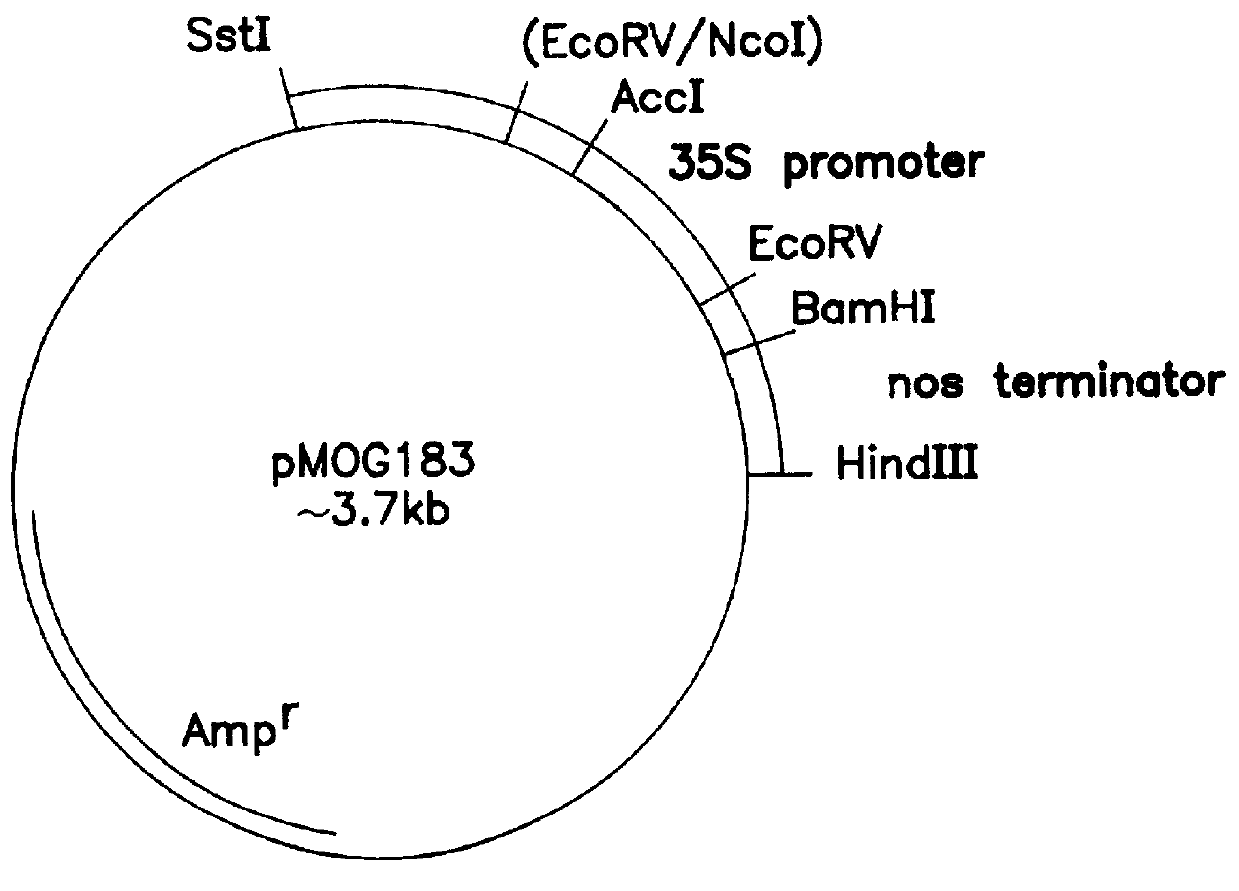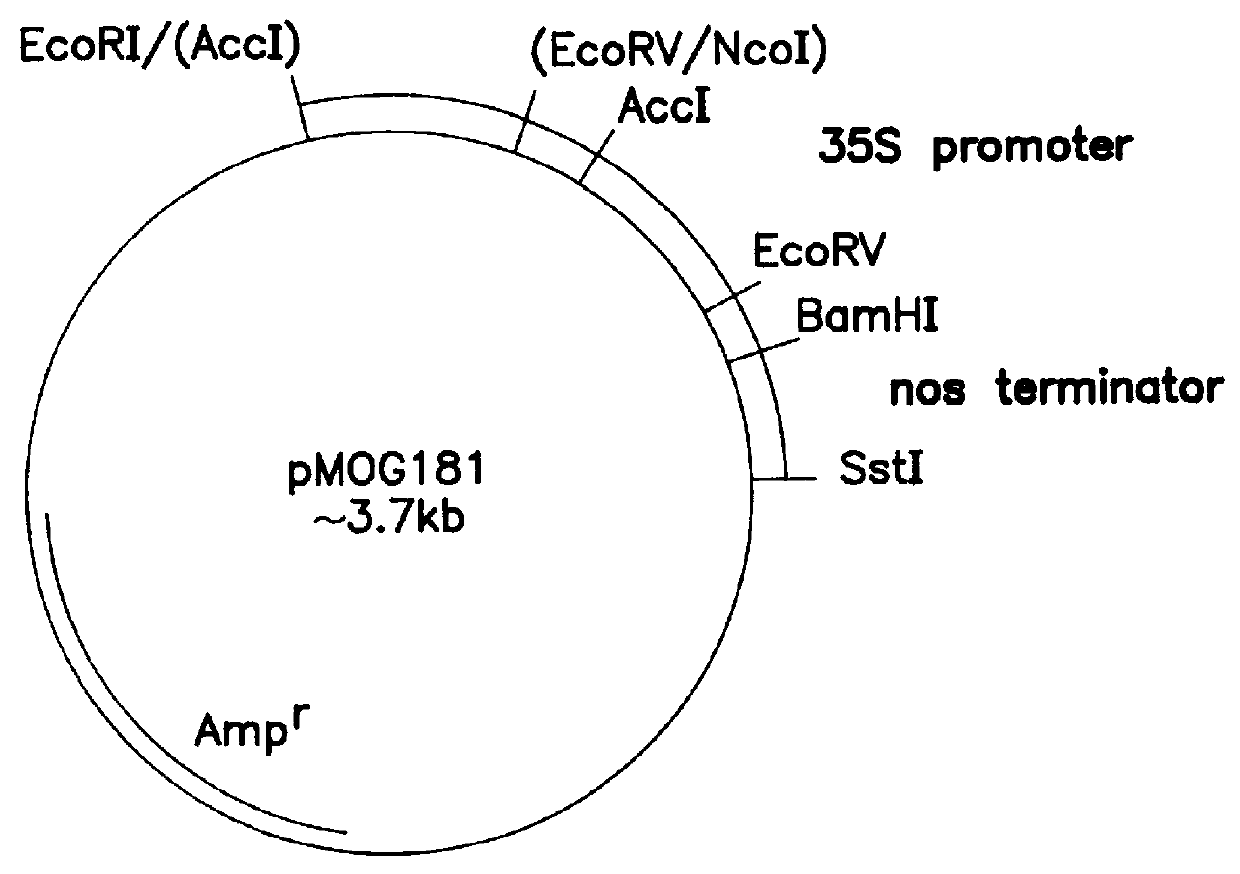Transgenic fungal resistant plants expressing chitinase and glucanase, process for obtaining, and recombinant polynucleotides for uses therein
a technology which is applied in the field of chitinase and glucanase-expressing plants, process for obtaining, and recombinant polynucleotides for use therein, can solve the problems of affecting the environment and the grower, affecting the survival of the plant, and affecting the growth rate of the plan
- Summary
- Abstract
- Description
- Claims
- Application Information
AI Technical Summary
Benefits of technology
Problems solved by technology
Method used
Image
Examples
example 2
Chitinase activity was assayed radiometrically with tritiated chitin as substrate (Molano et al., 1977) Tritiated chitin was synthesized by acytelation of chitosan with tritiated anhydride (Molano et al., 1977). The specific activity of the final product was approximately 1.2.times.10.sup.6 cpm / mg. Before use the tritiated chitin was washed three times. To 100 .mu.l 10 mM potassium phosphate buffer pH 6.4 with 0.02% sodium azide, 50 .mu.l tritiated chitin (approximately 150,000 cpm) and 50 .mu.l protein solution was added. The mixture was incubated shaking for 30 minutes at 37.degree. C. The reaction was stopped by adding 600 .mu.l 10% trichloro acetic acid. After centrifugation to pellet the chitin (10 minutes in a microfuge), 500 .mu.l supernatant was filtered over glasswool and pipetted into a scintillation vial. 5 ml scintillation fluid was added and the radioactivity was counted. The amount of radioactivity released (expressed as counts per minute) w...
example 3
Antifungal Activity of Chitinase
Antifungal activity of chitinases was assessed by the microtiter plate assay described above using the fungus Fusarium solani. Two purified extracellular tabacco chitinases (also known as pathogenesis-related proteins P and Q), a purified intracellular tobacco chitinase (32 kd protein) and a purified extracellular petunia chitinase were tested. In all cases the added activity was approximately 2000 counts per minute (meaning that this activitiy releases 2000 cpm from tritiated chitin in the chitinase assay). This activity is within in the range in which there is a linearity between protein concentration and activity. As controls bovine serum albumin (BSA), buffer or heat-inactivated chitinase was added. The results are shown in Table 1.
From the results in Table I it can be concluded that the extracellular chitinases of tobacco and of petunia do not possess antifungal activity.
example 4
4.0 The Cloning of cDNAs Corresponding with Chitinase
Polyadenylated RNA was isolated from. TMV-infected Samsun NN tobacco and double stranded cDNA was made using oligo(dT) as a primer (Hooft van Huijsduijnen et al., 1986) using standard techniques known to researchers in this area. The double stranded DNA was provided with "C-tails" which were hybridized with "G-tails" which were brought into the plasmid pUC9 after this plasmid was spliced open with PstI (Maniatis et al., 1982). The constructs obtained were used for the transformation of Escherichia coli MH-1. The transformants were brought in duplo on nitrocellulose filters. The first filter was hybridized in vitro with transcribed cDNA of poly(A)-RNA from TMV-infected tobacco, the other filter was hybridized with cDNA against poly(A)-RNA from healthy tobacco (Maniatis et al., 1982). Transformants which showed better hybridization with the first probe than with the second contained cDNA corresponding with mRNAs whose synthesis was ...
PUM
| Property | Measurement | Unit |
|---|---|---|
| pH | aaaaa | aaaaa |
| diameter | aaaaa | aaaaa |
| β | aaaaa | aaaaa |
Abstract
Description
Claims
Application Information
 Login to View More
Login to View More - R&D
- Intellectual Property
- Life Sciences
- Materials
- Tech Scout
- Unparalleled Data Quality
- Higher Quality Content
- 60% Fewer Hallucinations
Browse by: Latest US Patents, China's latest patents, Technical Efficacy Thesaurus, Application Domain, Technology Topic, Popular Technical Reports.
© 2025 PatSnap. All rights reserved.Legal|Privacy policy|Modern Slavery Act Transparency Statement|Sitemap|About US| Contact US: help@patsnap.com



